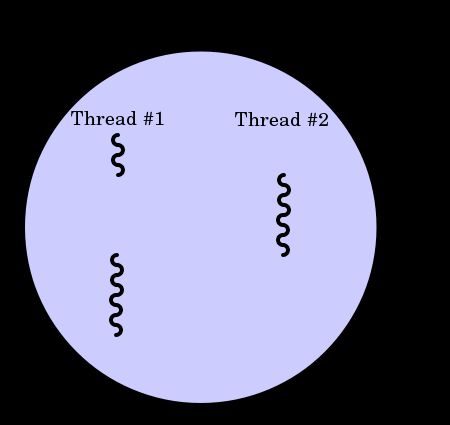1.进程、线程、多线程的区别
进程:
进程(process),是计算机中已运行程序的实体。
线程:
线程(thread)是操作系统能够进行运算调度的最小单位。它被包含在进程之中,是进程中的实际运作单位
多线程:
多线程(multithreading),是指从软件或者硬件上实现多个线程并发执行的技术。ps:我们所说的多线程一般指的是单进程内的多线程。
2.使用Java中的线程
Java中实现多线程编程有两种方式:
- 1.继承java.lang.Thread类
- 2.实现java.lang.Runnable接口
两种工作时性质是一样的。只不过使用继承的方式,最大的局限性就是不能支持多继承。
2.1自定义继承Thread类
public class CustomerThread extends Thread {
@Override
public void run() {
super.run();
System.out.println("customer thread!");
}
}
public class Client {
public static void main(String[] args) {
CustomerThread customerThread = new CustomerThread();
customerThread.start();
System.out.println("main 函数");
}
}
2.2自定义继承Runnable接口
public class CustomerRunable implements Runnable {
@Override
public void run() {
System.out.println("customer runable.");
}
}
public class Client {
public static void main(String[] args) {
CustomerRunable customerRunable = new CustomerRunable();
Thread thread = new Thread(customerRunable);
thread.start();
System.out.println("main 函数");
}
}
start()方法说明:the Java Virtual Machine calls the run method of this thread。换句话理解,就是当调用start()方法的时候,也就是告诉JVM此线程已准备完毕。等待JVM安排一个时间来调用Thread类中的run方法。
如果直接调用Thread.run()方法,那么就变成一个同步方法了,而不是一个异步处理的方式了。
因为Thread类也实现了Runable接口,所以Thread构造函数也可以传入Thread类。
3.实例变量与线程安全
自定义线程类中的实例变量针对其他线程可以共享也可以不共享
3.1不共享线程实例变量
public class MyThread extends Thread {
private int count = 5;
public MyThread(String name) {
super();
this.setName(name);
}
@Override
public void run() {
super.run();
while (count > 0) {
count--;
System.out.println("由" + this.currentThread().getName() + "计算,count=" + count);
}
}
}
public class Client {
public static void main(String[] args) {
MyThread a = new MyThread("a");
MyThread b = new MyThread("b");
MyThread c = new MyThread("c");
a.start();
b.start();
c.start();
}
}
3.2共享线程实例变量
public class MyThread extends Thread {
private int count = 5;
public MyThread(String name) {
super();
this.setName(name);
}
@Override
public void run() {
super.run();
count--;
System.out.println("由" + this.currentThread().getName() + "计算,count=" + count);
}
}
去除while的判断条件
public class Client {
public static void main(String[] args) {
MyThread myThread = new MyThread();
Thread a = new Thread(myThread, "a");
Thread b = new Thread(myThread, "b");
Thread c = new Thread(myThread, "c");
Thread d = new Thread(myThread, "d");
a.start();
b.start();
c.start();
d.start();
}
}
创建一个自定义线程实例,然后把自定义线程实例传递到Thread类中。这样a,b,c,d线程实例就能共享到myThread自定义线程实例的变量了。
3.3线程安全
如果不对资源进行访问控制,多个线程之间会出现线程竞争。为了避免出现这样的情况。可以在类上或者方法上使用synchronized关键字描述。意味给方法进行加锁。
加锁这段代码称为"互斥区"或"临界区"。
4.currentThread
currentThread可返回代码段正被哪个线程调用信息。
5.isAlive
判断当前的线程是否处于活动状态。
活动状态就是线程已经启动且尚未终止。处于正在运行或者准备开始运行的状态就是true。
6.sleep
在指定毫秒内让当前“正在执行的线程”暂停。
7.getId
取得线程的唯一标识
8.停止线程
interrupt()方法是中断线程。但是这个方法不会终止一个正在运行的线程,还需要加入一个判断才能完成线程的停止。
8.1判断线程是否停止状态
Thread类中提供了两种方法来判断线程的状态是不是停止的。
- 1.静态方法interrupted()
判断当前线程的状态。但是这个方法如果被连续调用两次。第二次返回的状态为false。(在第一次调用已清除了其中断状态后,且第二次调用检验完中断状态前,当前线程再次中断的情况除外)
/**
* Tests whether the current thread has been interrupted. The
* interrupted status of the thread is cleared by this method. In
* other words, if this method were to be called twice in succession, the
* second call would return false (unless the current thread were
* interrupted again, after the first call had cleared its interrupted
* status and before the second call had examined it).
*
* A thread interruption ignored because a thread was not alive
* at the time of the interrupt will be reflected by this method
* returning false.
*
* @return true if the current thread has been interrupted;
* false otherwise.
* @see #isInterrupted()
* @revised 6.0
*/
public static boolean interrupted() {
return currentThread().isInterrupted(true);
}
- 2.实例方法isInterrupted()
该方法再调用完之后,并不会清除状态标志。所以无论连续调用几次结果都是一样。
public boolean isInterrupted() {
return isInterrupted(false);
}
8.2代码演示
在实际的代码里,根据中断的状态来执行代码的停止。
public class CustomerThread extends Thread {
@Override
public void run() {
super.run();
for (int i = 0; i < 100; i++) {
if (this.isInterrupted()) {
System.out.println("已接收到停止命令!");
break;
}
System.out.println(String.format("i=%s", i));
}
System.out.println("哈哈,我还在...");
}
}
public class Client {
public static void main(String[] args) throws InterruptedException {
CustomerThread thread = new CustomerThread();
thread.start();
Thread.sleep(20);
thread.interrupt();
System.out.println(thread.isInterrupted());
System.out.println("main函数执行完毕!");
}
}
...
i=48
已接收到停止命令!
哈哈,我还在...
true
main函数执行完毕!
但是上面的方式并不能完全退出程序。比如还会执行for语句下面的sout代码。故需在接收到中断命令后,直接抛出InterruptedException异常。或者直接return
- try-catch方式
public class CustomerThread extends Thread {
@Override
public void run() {
super.run();
try{
for (int i = 0; i < 100; i++) {
if (this.isInterrupted()) {
System.out.println("已接收到停止命令!");
throw new InterruptedException();
}
System.out.println(String.format("i=%s", i));
}
System.out.println("哈哈,我还在...");
}
catch (InterruptedException error){
System.out.println(error.getMessage());
error.printStackTrace();
}
}
}
- return方式
@Override
public void run() {
super.run();
for (int i = 0; i < 100; i++) {
if (this.isInterrupted()) {
System.out.println("已接收到停止命令!");
return;
}
System.out.println(String.format("i=%s", i));
}
System.out.println("哈哈,我还在...");
}
不过还是建议使用try-catch方式来实现线程的停止。因为catch块可以将异常向上抛出,使得线程停止的事件得以传播。
9.yield
yield()方法的作用是放弃当前的CPU资源,将它让给其他的任务去占用CPU执行时间。但放弃的时间不确定,有可能刚放弃,马上又获取CPU时间
Thread.yield();
10.线程的优先级
在操作系统中,线程可以划分优先级,优先级高的线程得到的CPU资源越多,也就是CPU优先执行优先级高的线程对象中的任务。
setPriority()方法
public final void setPriority(int newPriority) {
ThreadGroup g;
checkAccess();
if (newPriority > MAX_PRIORITY || newPriority < MIN_PRIORITY) {
throw new IllegalArgumentException();
}
if((g = getThreadGroup()) != null) {
if (newPriority > g.getMaxPriority()) {
newPriority = g.getMaxPriority();
}
setPriority0(priority = newPriority);
}
}
Java中,线程的优先级分为1-10等级
Java中,线程的优先级具有继承性,比如A线程启动B线程,则B线程的优先级与A时一样的
11.守护线程
在Java线程中有两种线程,一种是用户线程,另一种是守护线程。
守护线程是一种特殊的线程,它的特性是陪伴。当进程中不存在用户线程,那么守护线程也会自动销毁。
例如GC,是一个守护线程

